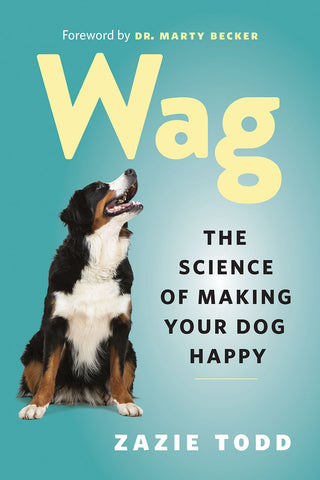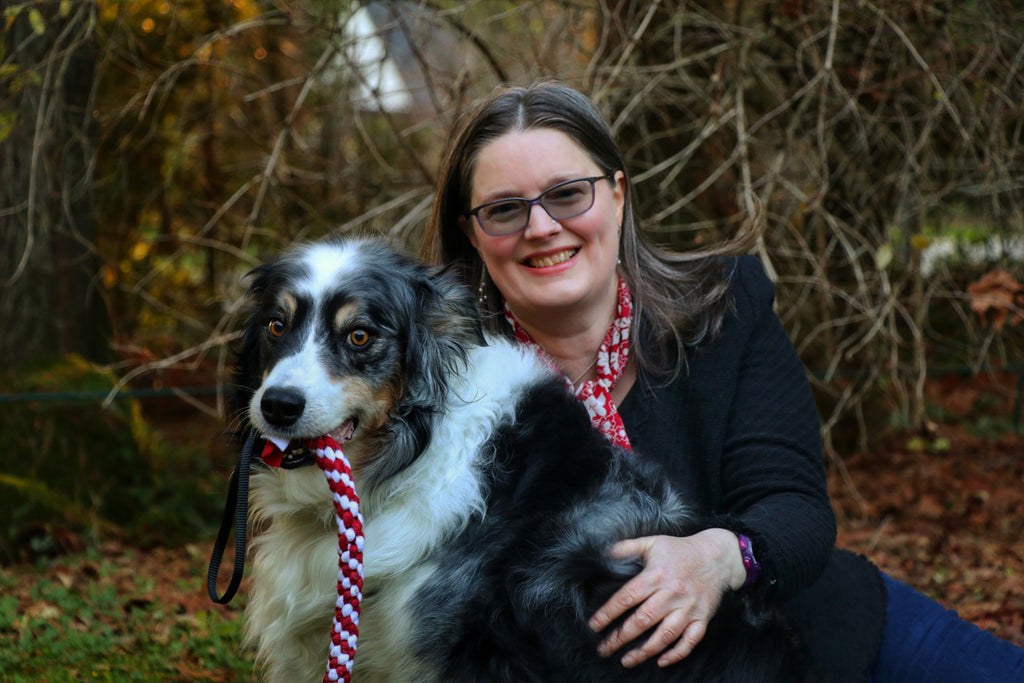 Zazie Todd is a social psychologist, certified dog trainer, and founder of the popular blog, Companion Animal Psychology, where she writes about everything from training methods to the human-canine connection. Wag: The Science of Making Your Dog Happy, is her first book.
Zazie Todd is a social psychologist, certified dog trainer, and founder of the popular blog, Companion Animal Psychology, where she writes about everything from training methods to the human-canine connection. Wag: The Science of Making Your Dog Happy, is her first book.
Continue reading to get to know Zazie, and to see some pictures of her *very* handsome dogs!
What inspired you to write this book?
I was inspired to write the book because ultimately, I want to make the world better for pet dogs (and their people). There is so much fascinating canine science at the moment, and it has very practical implications for our everyday lives with dogs. When dogs have behaviour problems, it can result in them being re-homed or even euthanized, but there is a lot we can do to prevent issues in the first place or to resolve or manage them. Wag: The Science of Making Your Dog Happy is full of practical tips to help people with their dogs, and it explains the science behind them so that people understand why their dogs matter.
You also run a popular blog, Companion Animal Psychology. What inspired you to start it?
The inspiration really came from my own two dogs: Ghost, a Siberian Husky/Alaskan Malamute cross, who sadly is no longer with us; and Bodger, a bouncy Australian Shepherd. I found that when I looked for information on dogs, a lot of it did not fit with what I knew from my background in psychology. Unfortunately there’s a lot of confusing information about dogs out there, so I wanted to share reliable information with people. I write one-to-two posts a week about dog and cat training and behaviour, and also run a popular animal book club. I love it when people write and tell me that my blog has helped them understand their dog (or cat) better.

Prioritizing your dog’s happiness might be new for people. Why is it important for dog owners to make sure their dogs are actually happy?
I think everyone wants their dog to be happy, but traditionally we’ve been told to make dogs be obedient and fit into our lifestyles. We know a lot more now about animal’s emotions, and so we’ve realized that it’s important to think about dogs’ happiness. This includes letting dogs express normal doggy behaviours and providing enrichment for them. It can be as simple as taking your dog on a “sniffari” and letting them sniff to their heart’s content, because smell is so important to dogs.
You talk about how people’s knowledge about dogs is often wrong due to misinformation. What’s the biggest misconception people have about owning and training their dog(s)?
I think the biggest misconception is to do with dog training, because many people still use aversive methods like leash jerks or shock collars to train their dog. Unfortunately, this risks causing fear, anxiety, and stress, and your dog may associate the punishment with you, which will affect your relationship with them. Positive reinforcement works really well and is the best way to train dogs. Unfortunately, dog training isn’t regulated and so I always tell people to look for a dog trainer who will use food as positive reinforcement to train their dog.

What were some of the surprises you encountered when you were researching for Wag?
For me the biggest surprise was the importance of the relationship between a person and their dog. Your dog loves you, and that has a lot of implications for how you should treat them. For example, if your dog is afraid of something, you can be a source of security and provide comfort to them. I think we all feel instinctively that we matter a lot to our dog; the surprise is the scientific evidence that shows just how much they care about us.
What do you hope readers will take away from Wag?
I hope readers will take away a better understanding of their dog, and tons of practical tips they can use to have a better relationship with their dog. Every chapter ends with a series of tips to apply the science at home, and at the end of the book there is a checklist people can use. The tips cover all aspects of a dog’s life, from helping them at the vet to ensuring they have a safe space to retreat to if they want peace and quiet. There’s even a section on end-of-life issues because I know this is the hardest time in a dog person’s life. My hope is that Wag will help people have a better relationship with their dog.
What advice do you have for people who are looking to get a dog?
Think about your lifestyle and what kind of dog would be a good match for you. For example, are you very active or are you looking for more of a couch potato? If you’re getting a puppy, be careful to find a responsible breeder. A responsible breeder will let you meet the mom, which is very important, and will quiz you to check that you will provide a good home. They’ll also take the puppy back if things don’t work out. But remember that there are lots of great dogs in shelters too, and sometimes an adult dog whose personality is known is the best fit for your family.
A note from Zazie:
Ghost was a Siberian Husky/Alaskan Malamute cross with the most amazing ice blue eyes. He loved other dogs, especially little dogs, and would jump out of his skin when they yapped at him. He was very gentle even though he was such a big dog. (Photo credit: Zazie Todd)
Bodger was an Australian Shepherd. He was delightful - very playful and a lot of fun, and he loved everyone. His favourite games were to fetch different toys, which he knew by name, and tug. He got on well with our cats, though he did like to herd them from time to time. Very sadly he had cancer and he passed in mid-Feburary. (Photo(s) credit: Bad Monkey Photography)

